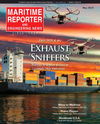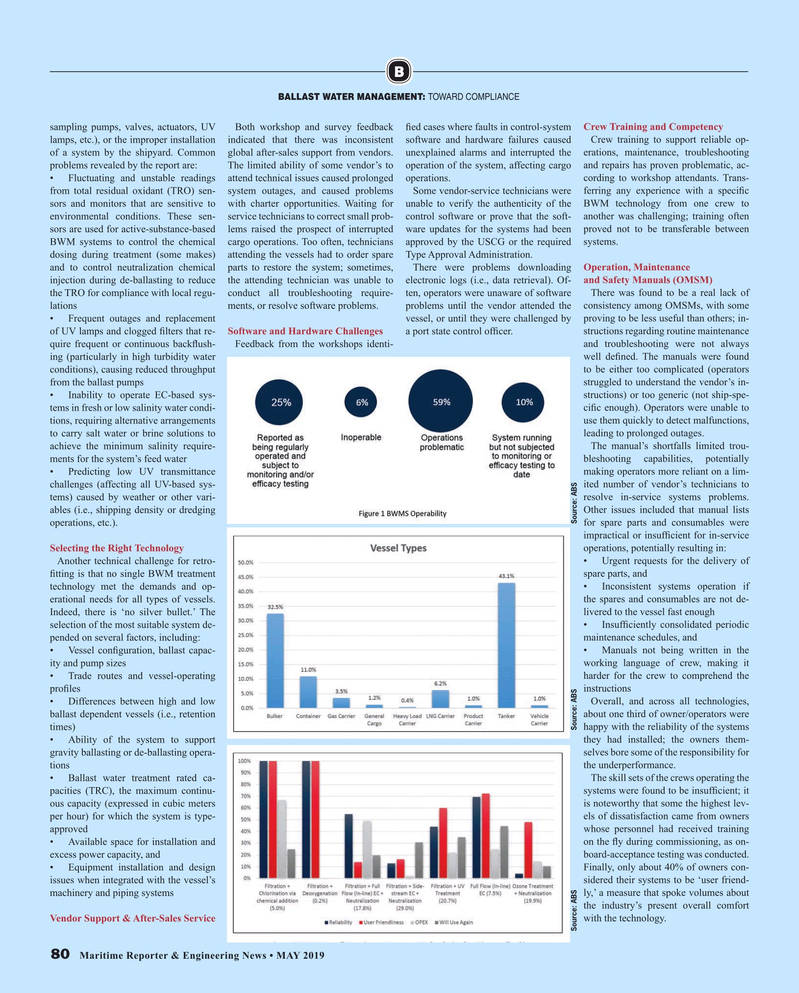
Page 80: of Maritime Reporter Magazine (May 2019)
Propulsion Annual - Green Marine Tech
Read this page in Pdf, Flash or Html5 edition of May 2019 Maritime Reporter Magazine
B
BALLAST WATER MANAGEMENT: TOWARD COMPLIANCE sampling pumps, valves, actuators, UV Both workshop and survey feedback ? ed cases where faults in control-system Crew Training and Competency lamps, etc.), or the improper installation indicated that there was inconsistent software and hardware failures caused Crew training to support reliable op- of a system by the shipyard. Common global after-sales support from vendors. unexplained alarms and interrupted the erations, maintenance, troubleshooting problems revealed by the report are: The limited ability of some vendor’s to operation of the system, affecting cargo and repairs has proven problematic, ac- • Fluctuating and unstable readings attend technical issues caused prolonged operations. cording to workshop attendants. Trans- from total residual oxidant (TRO) sen- system outages, and caused problems Some vendor-service technicians were ferring any experience with a speci? c sors and monitors that are sensitive to with charter opportunities. Waiting for unable to verify the authenticity of the BWM technology from one crew to environmental conditions. These sen- service technicians to correct small prob- control software or prove that the soft- another was challenging; training often sors are used for active-substance-based lems raised the prospect of interrupted ware updates for the systems had been proved not to be transferable between
BWM systems to control the chemical cargo operations. Too often, technicians approved by the USCG or the required systems.
dosing during treatment (some makes) attending the vessels had to order spare Type Approval Administration. and to control neutralization chemical parts to restore the system; sometimes, There were problems downloading Operation, Maintenance injection during de-ballasting to reduce the attending technician was unable to electronic logs (i.e., data retrieval). Of- and Safety Manuals (OMSM) the TRO for compliance with local regu- conduct all troubleshooting require- ten, operators were unaware of software There was found to be a real lack of lations ments, or resolve software problems. problems until the vendor attended the consistency among OMSMs, with some • Frequent outages and replacement vessel, or until they were challenged by proving to be less useful than others; in- of UV lamps and clogged ? lters that re- Software and Hardware Challenges a port state control of? cer. structions regarding routine maintenance quire frequent or continuous back? ush- Feedback from the workshops identi- and troubleshooting were not always ing (particularly in high turbidity water well de? ned. The manuals were found conditions), causing reduced throughput to be either too complicated (operators from the ballast pumps struggled to understand the vendor’s in- • Inability to operate EC-based sys- structions) or too generic (not ship-spe- tems in fresh or low salinity water condi- ci? c enough). Operators were unable to tions, requiring alternative arrangements use them quickly to detect malfunctions, to carry salt water or brine solutions to leading to prolonged outages.
achieve the minimum salinity require- The manual’s shortfalls limited trou- ments for the system’s feed water bleshooting capabilities, potentially • Predicting low UV transmittance making operators more reliant on a lim- challenges (affecting all UV-based sys- ited number of vendor’s technicians to tems) caused by weather or other vari- resolve in-service systems problems. ables (i.e., shipping density or dredging Other issues included that manual lists operations, etc.). for spare parts and consumables were impractical or insuf? cient for in-service
Selecting the Right Technology operations, potentially resulting in:
Another technical challenge for retro- • Urgent requests for the delivery of ? tting is that no single BWM treatment spare parts, and technology met the demands and op- • Inconsistent systems operation if erational needs for all types of vessels. the spares and consumables are not de-
Indeed, there is ‘no silver bullet.’ The livered to the vessel fast enough selection of the most suitable system de- • Insuf? ciently consolidated periodic pended on several factors, including: maintenance schedules, and • Vessel con? guration, ballast capac- • Manuals not being written in the ity and pump sizes working language of crew, making it • Trade routes and vessel-operating harder for the crew to comprehend the pro? les instructions • Differences between high and low Overall, and across all technologies, ballast dependent vessels (i.e., retention about one third of owner/operators were times) happy with the reliability of the systems • Ability of the system to support they had installed; the owners them- gravity ballasting or de-ballasting opera- selves bore some of the responsibility for tions the underperformance. • Ballast water treatment rated ca- The skill sets of the crews operating the pacities (TRC), the maximum continu- systems were found to be insuf? cient; it ous capacity (expressed in cubic meters is noteworthy that some the highest lev- per hour) for which the system is type- els of dissatisfaction came from owners approved whose personnel had received training • Available space for installation and on the ? y during commissioning, as on- excess power capacity, and board-acceptance testing was conducted. • Equipment installation and design Finally, only about 40% of owners con- issues when integrated with the vessel’s sidered their systems to be ‘user friend- machinery and piping systems ly,’ a measure that spoke volumes about the industry’s present overall comfort
Vendor Support & After-Sales Service with the technology.
Source: ABS Source: ABS Source: ABS 80 Maritime Reporter & Engineering News • MAY 2019
MR #5 (74-81).indd 80 5/2/2019 4:10:05 PM

 79
79

 81
81
